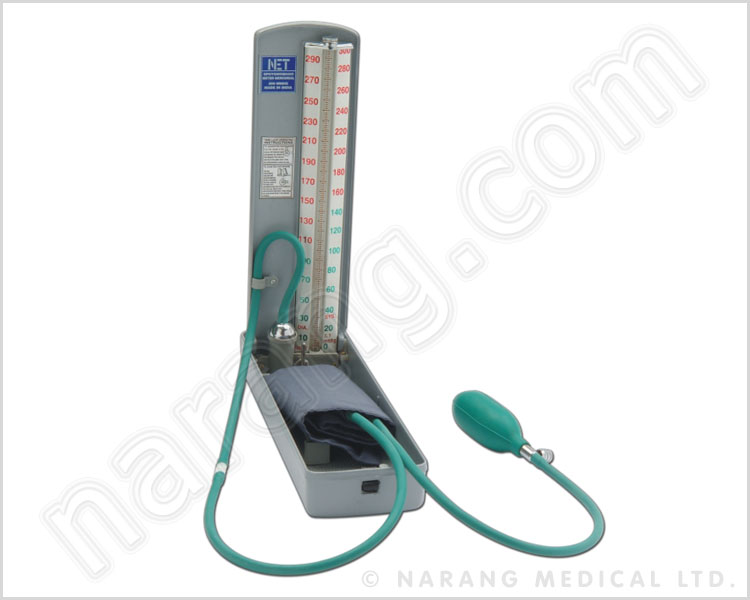- This Mercurial BP Apparatus is a desktop model capable of determining BP upto 300 mm/Hg. The complete inflation system is enclosed in an aluminium case.
Delivery time by Airmail » 2-3 weeks.
« View other Models in Sphygmomanometer Category
What is a Sphygmomanometer?
A sphygmomanometer or blood pressure monitor (also referred to as a sphygmometer) is a device used to measure blood pressure. This device has two major parts - an inflatable cuff to restrict blood flow, and mercury or mechanical manometer to measure the pressure. Sphygmomanometer is always used in conjunction with a means to determine at what pressure blood flow is just starting, and at what pressure it is unimpeded. A stethoscope is required while using manual sphygmomanometers. In medical terminology sphygmomanometer is an instrument for measuring arterial blood pressure and consists of an inflatable cuff, inflating bulb, and a gauge showing the blood pressure.
There are generally 3 types of Sphygmomanometer:
However, the auscultatory method with mercury sphygmomanometer has been the standard for blood pressure measurement for over 50 years. In a manual mercury sphygmomanometer, the pressure is displayed as the height of a column of mercury in a tube. As the cuff is manually inflated, the height of the column increases, and then decreases as the pressure is released. While the cuff deflates, the doctor usually listens with a stethoscope to the main artery of the arm.
How to Use a Mercury Sphygmomanometer
Step 1
Ensure you have a good Sphygmomanometer with an appropriately sized blood pressure cuff and a good quality stethoscope.
Step 2
Allow patient to relax for 5 - 10 minutes before you take the first reading. The patient should sit upright with their upper arm positioned so it is level with their heart and feet flat and apart on the floor. The area around the arm where BP cuff is to be wrapped should ideally be without cloth (or with the minimum cloth) as excess clothing might interfere with the BP cuff or constrict blood flow in the arm.
Step 3
Choosing the proper BP cuff size is key to accurate blood pressure measurement. Wrap the cuff around the arm and use the INDEX line to determine if the patient's arm circumference falls within the RANGE area. If not, use the appropriate smaller or larger cuff.
Step 4
Wrap the BP cuff around the arm. Ensure its not too tight.
Step 5
At the crease of the arm (the same arm where BP cuff is placed), locate the strongest pulse sounds and place the bell of the stethoscope over the brachial artery at this point.
Step 6
Now start pumping the cuff bulb as you hear the pulse sounds. Once the BP cuff gets inflated enough to stop blood flow you will not hear sounds through the stethoscope. The gauge should read 30 to 40 mmHg above the person's normal BP reading. If this value is unknown inflate the cuff to 160 - 180 mmHg. (If pulse sounds are heard right away, inflate to a higher pressure.)
Step 7
Now start deflating the BP cuff. Do it slowly. The pressure should fall at 2 - 3 mmHg per second, anything faster than this may likely result in an inaccurate measurement.
Step 8
Listen for the systolic pressure reading. The first sound heard as blood begins to flow through the artery is the patient's systolic pressure. You feel this sound similar to a tapping noise initially.
Step 9
Now listen for the diastolic pressure reading. Continue to hear the as the BP cuff pressure drops and the sounds fade. Note the gauge reading when the rhythmic sounds stop. This is the diastolic pressure.
Step 10
It is recommended to take blood pressure reading in both arms and then consider the average. If you wish to check blood pressure again, wait for 5 minutes (between readings). Normally, blood pressure is higher in the mornings and lower in the evenings.
Read More Articles...

